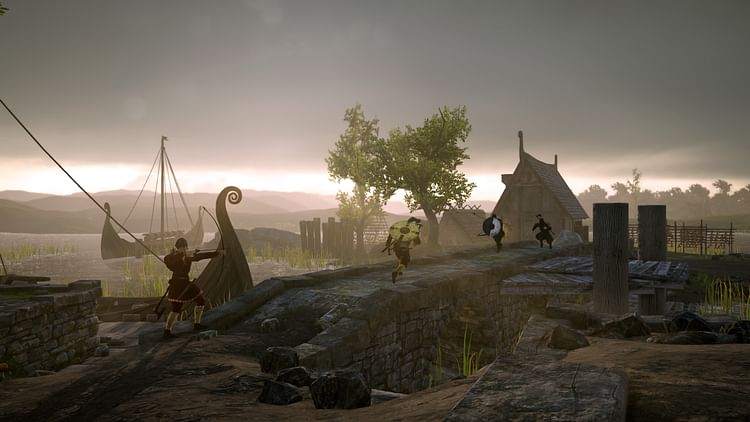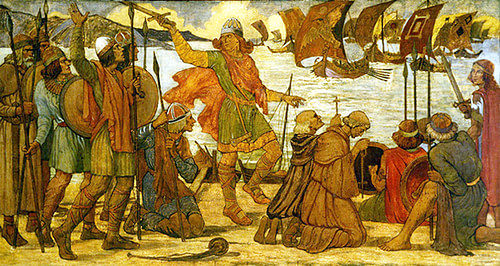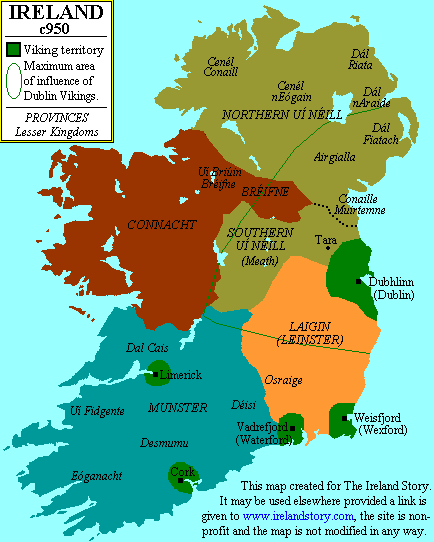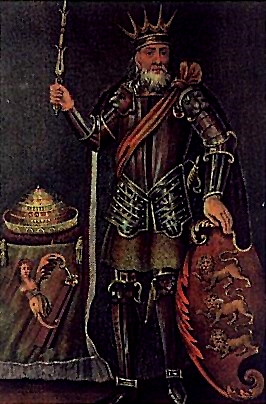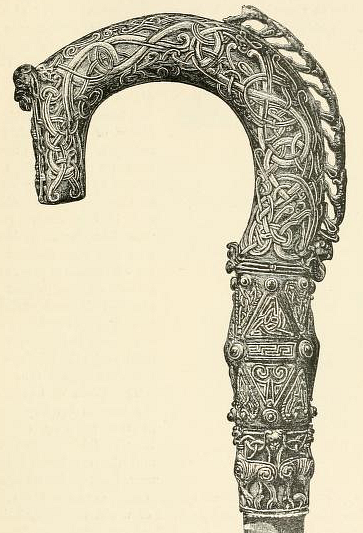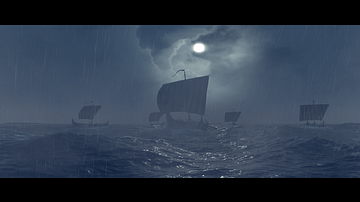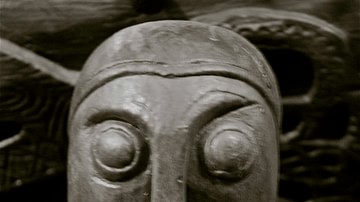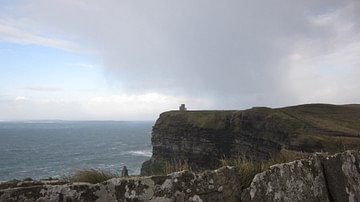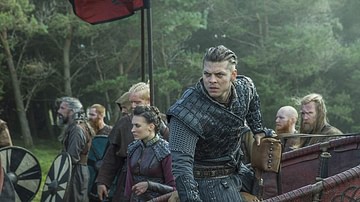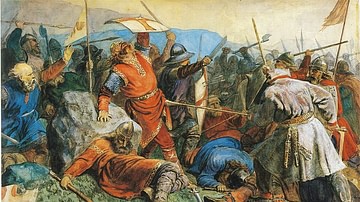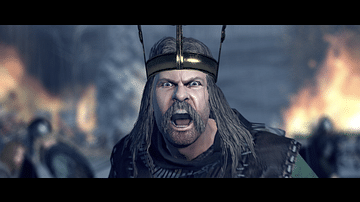In early Medieval Europe, a prime subject of frightening tales-come-true were the famously marauding and pillaging Vikings, spilling out of their dragon-headed longships in a state of bloodlust, thirsting for gold. With their menacing presence eventually stretching from eastern Europe and the Mediterranean all the way to North America, no land seemed safe – and it was early on in their globetrotting exercise that the Vikings zoned in on the appealing green shores of Ireland. From 795 CE onwards, monasteries and towns were looted or destroyed in persistent raids, followed by the building of forts and settlements which allowed these Norsemen to become wildcard players on the Irish political scene. The Vikings, although losing their autonomous power in the late 10th to early 11th century CE, had by then already integrated into Irish society through intermarriage and close contact with the locals, and left a lasting mark on both commerce and culture.
The draw
What exactly motivated the Vikings to set sail for Ireland (or the British Isles in general), though, is subject to ongoing debate. In western Norway, where land that did not try to kill you or your crops was a bit scarce, a search for new land may have been a small push factor. This seems to fit with the Norwegian Vikings beating their fellow Scandinavians to the punch in expanding westwards, reaching Orkney by the 7th century CE. It was the Norse who ended up on Irish shores.
When, from around the end of the 7th century CE, increased commercial contacts with western Europe brought the Scandinavians whispers of riches in Europe as well as stories of the kingdoms' internal conflict, a pull factor neatly presented itself on a silver platter. What is more, the Scandinavians picked up the technical knowledge of sails – something they originally lacked – from western Europe, too, which allowed them to remodel their timid boats into quick and deadly vessels. Just like that, all the makings of a successful raiding expedition were there.
The early raids (795-837 CE)
The Irish medieval annals, penned by monks and clerics that were among the eye-witnesses, record the first Viking raid in 795 CE when the island of Rathlin off the northeast coast of the mainland and the great monastery of St. Columba on the island of Iona were attacked by strangers. They had come out of the blue, sweeping in and out and carrying off their treasures in likely fairly uncoordinated expeditions set up by independent warbands. In the years that followed, the Vikings took their ships into the Irish Sea, for instance burning St. Patrick's Island just north of Dublin in 798 CE. These initial endeavours were carried out by no more than two to three ships at a time – hardly fleets stacked with countless Norsemen – in a hit-and-run fashion.
By 807 CE the Vikings had pushed around to the western bays, too, and most of the targets they picked – monasteries and small towns – were easy prey; they had the elements of surprise and speed and generally stayed within 30 km of navigable water, which kept them highly mobile. Despite a few instances of successful local resistance, the Irish probably had an underdeveloped fleet, no coastal forts and an impractical 480 km of coastline to defend; a bit of a hopeless job. The appeal of the monasteries was obvious: housing more than just monks, fine metalwork was made here to embellish holy books as well as reliquaries and stored treasure was abundant too, making for easily transportable loot. The community on Iona was so shaken up after being raided in 795 CE, burned in 802 CE, and seeing 68 of their community torn apart by Viking axes in 806 CE that they actually rehoused their treasures and some of their staff to a new monastery built inland at Kells.
Understandably annoyed at this whole situation, the person jotting down the record in the Irish Annals of Ulster (our main source on the Viking raids; they are off by one year in their counts but are here referenced in corrected fashion) for the year 820 CE complains that at that time:
The sea spewed forth floods of foreigners over Erin, so that no haven, no landing-place, no stronghold, no fort, no castle might be found, but it was submerged by waves of Vikings and pirates. (820)
In the first 40 years that the raiders came knocking on Irish doors, the Vikings remained faceless wraiths, harrying the Irish coastal regions mostly in the northern half of Ireland and plundering many monastic centres. Before 837 CE no Viking names appear in any of the Irish records, and it is not until the mid-9th century CE that Viking kings start popping up at all; this early phase of raids was only a prelude.
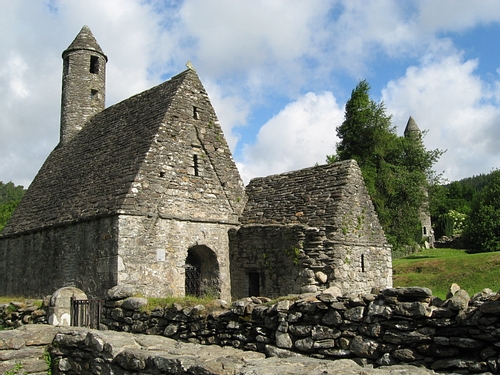
Increasing pressure & settlement (837 CE onward)
The early raids had made clear Ireland's potential to treasure-hungry eyes, and from the 830s CE the Norse Viking groups amped up the pressure, the Irish annals listing around 50 specific attacks on monasteries and nine big raids on churches and people in places such as Leinster and the Uí Néill lands between c. 830 and 845 CE. Not just valuables were stolen; taking captives and striking up the ransom was a good way to make some cash, too.
A new phase in the Vikings' involvement with Ireland is identifiable from 837 CE. Following the already increasing scale of raids, in this year a much more mammoth-sized fleet of Vikings sailed up the rivers Liffey and Boyne into the inland territories, attacking the lands of Brega in the south of County Meath:
A naval force of the Norsemen sixty ships strong was on the Bóinn, and another one of sixty ships on the river Life. Those two forces plundered the plain of Life and the plain of Brega, including churches, forts, and dwellings. The men of Brega routed the foreigners at Deoninne in Mugdorna of Brega, and six score of the Norsemen fell. (The Annals of Ulster, 837. 3)
These ships, probably sailing from the Viking-occupied areas in Scotland, seem to have carried around a healthy 3,000 men in total, who for the first time butted their heads against proper local resistance, a theme that was carried on as a force of southern Uí Néills stood up against the Vikings, too, although less successfully as of them "an uncounted number were slaughtered" (Annals of Ulster, 837. 4). Pushing up the inland waterways of the east midlands, where they soon became a regular sight, instead of their former pin-pricks along the coastlines, the Vikings now seem to have been organised in royal expeditions hailing from Viking Scotland, with chieftains or kings tying together several groups and splurging out on resources to support these missions. With this new inland focus, forts, farms, and towns now increasingly came under threat, too. Overall, from 837 CE onward, larger targets (such as the greater monastic towns Armagh, Glendalough, Kildare, Slane, Clonard, Clonmacnoise, and Lismore) were hit by larger forces than in the early days, while smaller, local churches where there was less to be plundered may have escaped the onslaught.
Greater expeditions brought greater rewards, and although the religious artefacts that the Norse looted generally did not have the highest metal value, the fact that they carried meaning to the Christian Irish meant they could be ransomed off. Slave-taking – unusual for the local Irish – was also a regular feature of the Viking raids in general and helped fill up the till.
Unfortunately for the Irish, instead of the winter cold interrupting the Viking raiding seasons and giving them some time to breathe, from at least 840 CE onward, the Norse began to overwinter in Ireland. They bunkered down at Lough Neagh in that year and set up the first coastal fortresses which also housed their ships, known as longphorts, in at least 841 CE, including one at Dublin. As the annalists note, in 841 CE "There was a naval camp [longphort] at Duiblinn…" (841. 4), and then, with almost palpable surprise, the entry for 842 CE states "The heathens still at Duiblinn" (842. 2). Raids could now be sprung upon unsuspecting targets in the middle of winter, with slaves kept prisoner in the Vikings' brand-new winter quarters.
The Vikings' longphorts became their strategic footholds functioning as stepping stones for increased plundering activities along the Irish coastline, and also foreshadowed their more long-term settlement in places such as Wicklow, Waterford, Wexford, Cork, Limerick, and Dublin, where they gradually incorporated the surrounding area into coastal kingdoms that competed with the other Irish and Norse ones around them. Contrasting with the situation in England and Scotland, however, the Norse never gained any substantial Irish territories.
Resistance & convergence
These new developments had a fair few knock-on effects. The Vikings threat could no longer be ignored – not even by the Irish greater kings who so loved bashing in each other's skulls and feuding amongst themselves – and by 845 CE Niall Caille, king of Tara, discovered he was well capable of inflicting a defeat on a bunch of Vikings in Donegal. Many Irish military successes, such as the one by Maél Sechnaill I (a descendant of the southern Uí Néill dynasty who styled himself High King of Ireland) in 848 CE in which 700 Vikings allegedly bit the dust, followed. The Vikings' formerly dynamic presence had shifted to them becoming somewhat sedentary ducks in their longphorts, making them more vulnerable to this stiffened Irish resistance.
Besides antagonising the locals, the Vikings' settlement actually also drew them into the Irish political scene, as Donnchadh Ó Corráin explains:
The Irish kings now made war on them [the Norse], now used them as allies and mercenaries in the shifting web of alliances at the centre of which lay the Uí Néill [an Irish dynasty] attempt to make themselves kings of Ireland. (Ó Corráin in The Oxford Illustrated History of the Vikings, 89-90)
With neither the Irish nor the Vikings being united, mixed groups of both could be found opposite each other. These alliances started going hand in hand with intermarriage at the very tops of these groups' social hierarchies, drawing the Vikings ever closer into Irish society as a whole, and, by the second half of the 9th century CE, the Viking presence had become a familiar sight in Ireland. Tribute exacted from the lands they controlled and trade they conducted with the Irish also led the Vikings to build up commercial ties with their hosts.
However, the Norse Vikings, busy trying to milk a stubborn Ireland to the best of their abilities, did not remain unchallenged. After decades of being the only magpies around, in 849 CE a Danish fleet came to check up on them and sailed into Irish waters. The Annals of Ulster record that:
A naval expedition of seven score ships of adherents of the king of the foreigners (righ Gall) came to exact obedience from the foreigners who were in Ireland before them, and afterwards they caused confusion in the whole country. (849)
The Danes clearly had the Norse – and not the Irish – as their target; in 851 CE they attacked both Viking Dublin and the longphort at Linn Duachaill, and defeated the Norse after a three-day long naval battle at Carlingford Lough in 853 CE, after which the Norse bounced back and finally drove the Danes off. With the Norse and the Danish as rival Viking groups, according to Dáibhí Ó Cróinín (250-251), it is not impossible that the Irish had initiated an alliance with the Danes and then sat back to watch things unfold.
By the end of the 9th century CE it had become clear to the Norse that Ireland would not part with its riches or its land as (relatively) easily as some of the other Viking territories like the ones in Frankia and England. Beyond their handful of settlements and their involvement in Irish society, the Viking presence could not stretch its wings much further and kept getting caught in Irish resistance. This may have pushed them to seek easier pickings in Iceland and the northwest of England, which reduced some of the pressure on Ireland.
Viking Dublin
Viking Dublin, which had begun as a longphort in 841 CE and was taken over by a branch of Scottish Vikings led by Amlaíb (or Olaf) who teamed up with another Viking leader, Ímar (or Ivarr), in around 853 CE, probably suffered from similar difficulties. These two had transformed Dublin and the Irish Sea into the hub of Norse activity ranging from Scotland and England to the Isle of Man. For over 20 years their names are found time and again in the annals due to them wreaking havoc across the country and getting stuck into the northern Irish Sea region's politics. However, after Ímar's death in 873 CE, the records go quiet in terms of heavy-duty Viking activity in Ireland and it becomes hard to trace the doings of the Dublin kingdom's dynasty, who might have become internally divided at this time.
In 902 CE we are illuminated once more, though; what was left of the Dublin Vikings were driven out of town by the combined forces of Brega and Leinster:
The heathens were driven from Ireland, i.e. from the fortress of Áth Cliath [Dublin]…and they abandoned a good number of their ships and escaped half dead after they had been wounded and broken. (The Annals of Ulster, 902. 2)
With Dublin now in Irish hands, it seems loads of Vikings upped and left Ireland and in more than a few cases camped out in England instead, for the time being.
After only a short break, in 914 CE the Waterford coast saw the sudden appearance on the horizon of a large amount of Viking sails, edging closer and closer, its human cargo reclaiming Waterford and ravaging the surrounding lands of Munster. Other bases such as Wexford, Cork, and Limerick were also hardhandedly returned to the Viking fold around this time, while Dublin was taken over by the original Dublin Viking group who also happened to rule York and Northumbria at this point in time. This overarching dynastic connection spurred on trade and urbanisation in the whole of Ireland as well as greatly boosting the resources of its single king, transforming Dublin into an economic and political centre from which the Irish kings also profited.
The Viking tale of Ireland finally takes its last turns around the end of the 10th century CE. It began with the Dublin Viking king Amlaíb Cuarán getting a bit overconfident, having conquest on his mind. After plunging his army's swords into many Irish necks including that of the king of Leinster, he was promptly defeated in the kingdom of Meath in the battle of Tara, 980 CE in what the annalist calls "a red slaughter" (Brink & Price, 432). Mael Sechnaill mac Domnaill, king of Meath, then successfully steamrolled on towards Dublin, who in its surrender had to free all Uí Néill lands from tribute and free the Irish slaves within Viking territories. All of the Viking cities now came under either direct or indirect control of the Irish kings.
With the dragon-headed ship already pretty much sailed and the remaining Norse steadily integrating into the Irish political scene, the Battle of Clontarf fought in 1014 CE – despite its legendary status – simply reinforced this trend. Brian Boru, High King of Ireland encroached upon Dublin aided by Limerick Vikings, while the men of Leinster stood beside the Dublin Vikings in the typically mixed bag of alliances which had so come to characterise Irish politics in this period. The great melee that followed saw Brian Boru fall but Dublin lose, thus piling onto the earlier 980 CE defeat and snugly fitting Dublin as well as the other Viking cities further into the Irish political structure; they were now ruled by Irish overlords who saw them as "sources of income and power, not as the citadels of foreigners to be sacked" (Ó Cróinín, 267). The epilogue comes in the form of the Norman invasion of England in 1066 CE, whose descendants washed over Ireland from 1169 CE.
Impact on Ireland & legacy
The picture of raiding Vikings unleashing their brutality and destruction upon Ireland seems clear from the early medieval accounts and, for good measure, tends to be etched in today's minds. However, when looking closer at the context, one can only conclude that this is massively exaggerated. In terms of frequency, raids were not exactly a constant hazard during the early period, with only 25 monastic raids recorded between 795-829 CE while Ireland had a veritable sea of monasteries and churches in total. Even the ones that were hit more than once clearly bounced back fast enough to be hit again, and overall most monasteries survived this era.
The damning judgement of bloodthirst attached to the Vikings stems from the hands of the very clerics who were in the first line of fire and obviously very upset at these 'heathens' or 'pagans' coming in and despoiling their sanctuaries. This hatred seeps through in their writings and gives an unfair impression of mass-scale destruction; rather than all "havens" being "submerged by waves of Vikings" (The Annals of Ulster, 820), although probably traumatic, the raiding reality was a bit milder than that. Moreover, during the Viking period, the Irish themselves actually plundered more churches than the Norse did, and they would certainly not have needed any lessons in brutality from the Norse, being quite educated in that respect themselves already.
Although the territories the Vikings took were not very large and thus did not have a huge geographical impact on Ireland, the Vikings did end up significantly influencing Ireland in a political, economic, and cultural way. The Irish took over some Norse cues regarding warfare, especially regarding weapons and tactics, but it was the Viking longphorts grown into towns with commercial characters that gave Ireland, formerly lacking proper towns, a major, lasting boost. Furthermore, the extended Viking ties with the rest of the British Isles and continental Europe enlarged the Irish trading scene in general.
The progressing integration (reinforced by intermarriage) of the Viking kingdoms into Irish society especially throughout the 10th century CE not only saw Vikings embracing the same Christianity whose houses of worship they had initially come to attack but also saw Irish kings influenced by Viking ideas of kingship, which were more overarching. Finally, the most tangible impact to us can be seen in art and language: Scandinavian styles can be seen throughout Irish metalwork as well as the stone crosses of the time, and both names, as well as terms relating to typical Viking activities such as shipping, were loaned by the Irish, such as the splendid Old Norse knattar-barki (a small studded boat) becoming the Irish cnaturbarc.
The Viking's exaggeratedly crazy reputation has ensured their survival in Europe's collective memory, and despite being taken down a peg or two on contextual grounds their intricate relationship with Ireland is both fascinating and noteworthy.
